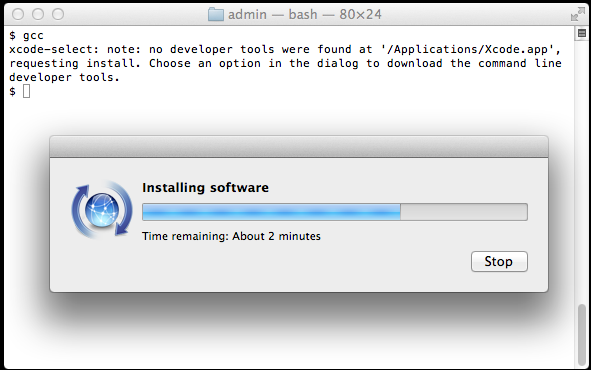

The next step is adding arguments to allow user input. This is the very basic setup for our command-line tool! You can see this by building and running the code:
Xcode command line tools install code#
The created code is very simple and only contains a “Hello, world!” print statement. gitignore file that is adjusted for working a Swift Package. The command will print out the following lines:Ĭreating Tests/BannerTests/BannerTests.swiftĬreating Tests/BannerTests/XCTestManifests.swiftĪs you can see, it automatically took the folder name as the name of the executable. We first created a new folder called Banner, changed directory to this new folder, and then initialized the new package with the type set to executable. In this example, I’m going to use the name Banner for creating the blog post banners. We initialize a new project by making use of the Swift Package Manager. Once you’ve found something you can automate or replace by a command-line tool, it’s time to dive in and start creating it. If you’re unfamiliar with the Swift Package Manager, I highly encourage you to first read my blog post called Swift Package framework creation in Xcode. GitBuddy: Your buddy in managing and maintaining GitHub repositories.Ĭreating a command-line tool using the Swift Package Manager.
Xcode command line tools install simulator#

You should not create a command-line tool for everything. Try it today! When should I decide to create a command-line tool? Get more from your QA process Waldo automates the capture of quality debugging information for iOS developers during the QA process, so you don’t have to rely on a vague bug report to address issues in your build. I’ve created a Poes, a command-line tool for testing push notifications in the simulator, in just a few hours! Once you’ve created your first command-line tool, it’s fairly easy to quickly set up another one. The Swift Package Manager makes it a lot easier to create command-line tools as we can write them in Swift. While developing iOS applications we often make use of command-line tools like Fastlane and CocoaPods but it’s less common to write your own command-line tools for daily use. 7 min read Creating a command line tool using the Swift Package ManagerĪ command-line tool can be very useful for automating common tasks to boost developer productivity.Creating a release and installing your command-line tool.Making use of our Swift Command-line tool.Adding a subcommand by using the ArgumentsParser for reading user input.Creating a command-line tool using the Swift Package Manager.When should I decide to create a command-line tool?.


 0 kommentar(er)
0 kommentar(er)
